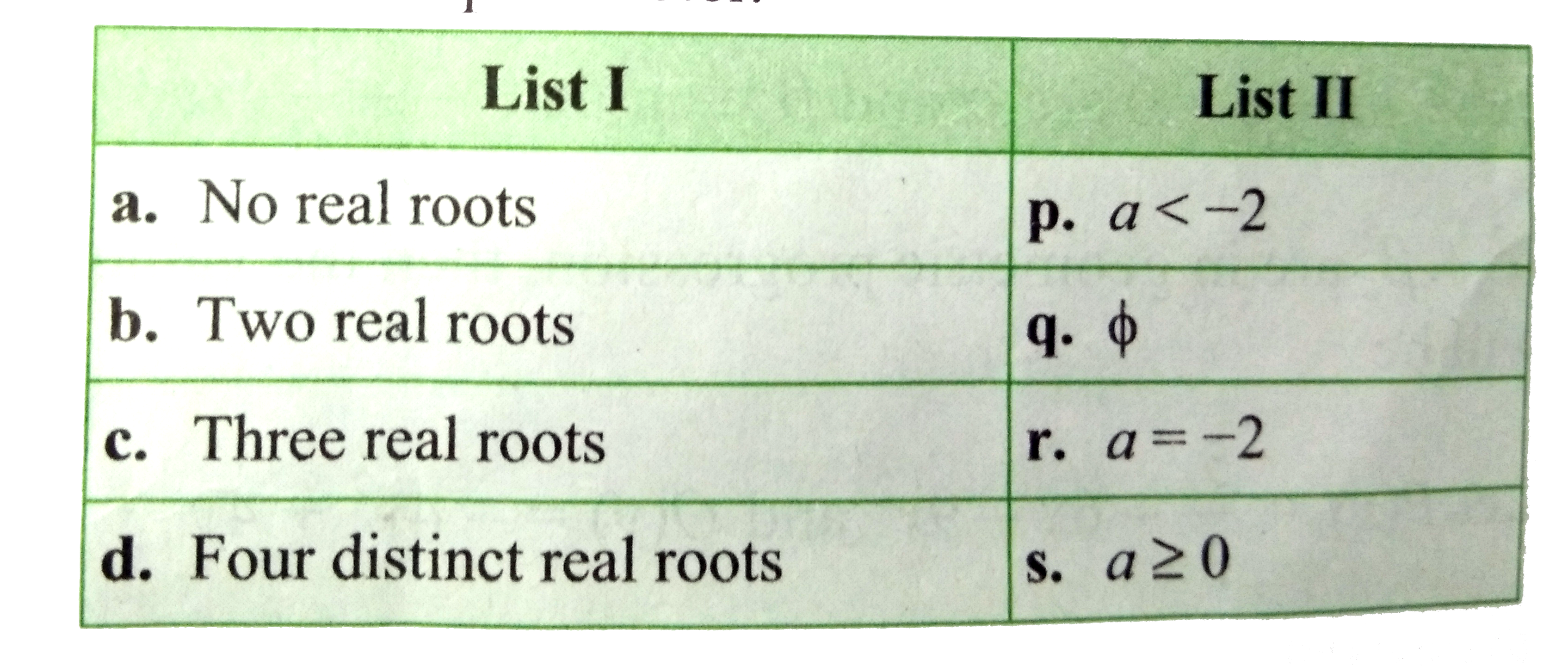If (a2−14a+13)x2+(a+2)x−2=0 does not have two distinct real roots, then the maximum value of a2−15a is _________.Solution in Bengali
The correct Answer is:-9
Let f(x)=(a2−14a+13)x2+(a+2)x−2
Given that the above equation does not have two distinct real roots.
Therefore, either f(x)≥Oorf(x)≤O∀x∈R.
But f(0)=−2<0
∴f(0)≤0∀x∈R
So, f(−1)≤0
⇒(a2−14a+13)−(a+2)−2≤0
⇒a2−15a+9≤0
⇒a2−15a+9≤0
So, the maximum value of a2−15a is −9
Topper's Solved these Questions
- BOOK - CENGAGE PUBLICATIONCHAPTER - THEORY OF EQUATIONSEXERCISE - Archives JEE MAIN (single correct Answer Type )7videos
THEORY OF EQUATIONS
- BOOK - CENGAGE PUBLICATIONCHAPTER - THEORY OF EQUATIONSEXERCISE - JEE ADVANCED (Single Correct Type )5videos
THEORY OF EQUATIONS
- BOOK - CENGAGE PUBLICATIONCHAPTER - THEORY OF EQUATIONSEXERCISE - MATRIX MATCH TYPE6videos
THEORY OF EQUATIONS
- BOOK - CENGAGE PUBLICATIONCHAPTER - STRAIGHT LINESEXERCISE - ARCHIVES (NUMERICAL VALUE TYPE)1videos
STRAIGHT LINES
- BOOK - CENGAGE PUBLICATIONCHAPTER - THREE DIMENSIONAL GEOMETRYEXERCISE - All Questions291videos
THREE DIMENSIONAL GEOMETRY
Similar Questions
If the roots of the equation bx2+cx+a=0 be imaginary, then for all real values of x, the expression 3b2x2+6bcx+2c2 is (1) greater than 4ab (2) less than 4ab (3) greater than −4ab (4) less than 4ab
04:17View SolutionQ. Let p and q real number such that p≠0,p2≠q and p2≠−q. if α and β are non-zero complex number satisfying α+β=−p and α3+β3=q, then a quadratic equation having αβ and βα as its roots is
08:19View SolutionMatch the following for the equation x2+a|x|+1=0 where, a is a parameter.
 02:36View Solution
02:36View SolutionFor a point P in the plane, let d1(P)andd2(P) be the distances of the point P from the lines x−y=0andx+y=0 respectively. The area of the region R consisting of all points P lying in the first quadrant of the plane and satisfying 2≤d1(P)+d2(P)≤4, is
02:19View SolutionFind the angle between the line whose direction cosines are given by l+m+n=0andl2+m2−n2=0.
03:52View SolutionIf the equation (x1+x2)2+a(x1+x2)+3=0 has exactly two real roots which are distinct, then the set of possible real values of a is (−132,0) (b) (∞,−132) (−132,132) (d) (132,∞)
03:20View SolutionIf the two roots (a-1)(x^(4)+x^(2)+1)+(a+1)(x^(2)+x+1)^(2)=0 are real and distinct,then the set of all values of 'a ' is.....
04:16View SolutionIf x^(2)-4x+log_((1)/(2))a=0 does not have two distinct real roots,then maximum value of a is
03:48View SolutionIf x2+ax−3x−(a+2)=0 has real and distinct roots, then minimum value of (a2+1)/(a2+2) is
03:00View SolutionIf (a2−14a+13)x2+(a+2)x−2=0 does not have two distinct real roots, then the maximum value of a2−15a is _________.
04:05View Solutionयदि x2−4x+log1/2a=0 के दो पृथक रूप से वास्तविक मूल न हो , तो a का अधिकतम मान है
04:09View SolutionIf ax2+bx+6=0 does not have distinct real roots, then find the least value of 3a+b.
04:58View SolutionIf x2+ax−3x−(a+2)=0 has real and distinct roots, then minimum value of (a2+1)/(a2+2) is
07:05View SolutionIf ax2+bx+6=0 does not have distinct real roots, then find the least value of 3a+b.
04:28View SolutionIf (a2−14a+13)x2+(a+2)x−2=0 does not have two distinct real roots, then the maximum value of a2−15a is _________.
02:14View SolutionIf the equation (x1+x2)2+a(x1+x2)+3=0 has exactly two real roots which are distinct, then the set of possible real values of a is (−132,0) (b) (∞,−132) (−132,132) (d) (132,∞)
03:34View Solution

